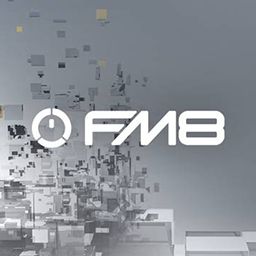
You can morph between 4 different patches in FM8's Morph Grid.ĩ. FM8 has a dual parallel/serial multimode filter. FM8 has an arpeggiator with step sequencer functionality.ģ. If you were like me, then you immediately recognized that when you saw it.Ģ. Algoritm's matrix is inspired by (or copied from) FM8's. I think you'll be surprised how advanced it is.ġ. It's still the most powerful FM synth on the planet, and for all of you more experienced synth users who didn't fall for the Algoritm hype, here are 14 FM8 fun facts that you maybe didn't realize were a thing. It also lacked velocity sensitivity, and could only hold 20 patches at a time, as opposed to the DX7’s 32 patches.FM8 is still my favorite FM synth, even though it was introduced FOURTEEN years ago in 2007. 6 operators, one timbre and no effects.ĭX9 (1983): Budget, reduced-feature version of the DX7, featuring only 4 operators, meaning less complex sounds. Only 140 were made! Its prototype was the Yamaha CSDX, which was never released.ĭX5 (1985): A rerelease of the DX1, but without the fancy keyboard, polyphonic aftertouch or wooden sides, and at a much lower price point.ĭX7 (1983): The most famous, and widely produced of the DX synths. Also contains double the voice memory of the DX7, polyphonic aftertouch, and a very fancy wooden case. Like most synths, the naming convention is as confusing as possible, so here’s the breakdown:ĭX1 (1983): The biggest and most powerful of the DX series, features two sets of synth chips, allowing double polyphony, split voices, or layered voices. The DX7 had six, cheaper models had four, and more expensive models had two sets of six. The biggest differences between models are the number of operators, which are responsible for creating the sound. Because of the DX7’s popularity, Yamaha created a lot of new models, including upgraded and module versions.

The DX synths ranged from expensive beasts to cheap consumer models, with the DX7 sitting in the middle. In this article I’ll explore the DX7 and other DX synths, I’ll look at how they work, and then play some songs they were used in. Because of this, the DX7’s presets were used more than new sounds, so the same recognisable sounds started to crop up in pop and rock sounds from 1983 onwards. Programming sounds was also cumbersome on the DX synths, involving menu diving and adjusting of numbers and ratios to create a new sound. The FM technology was used in an earlier synths, such as the Synclavier I & II, and the Yamaha GS1, however these were all super expensive synths, so the DX line was Yamaha’s bid at making an affordable FM synthesizer for working musicians.įM synthesis was complicated, especially compared to the simple monosynths and polysynths before it. Although released in 1983, the technology behind it was developed in 1967 by John Chowning, a professor at Stanford University. The DX7 generated its sound using a new method of synthesis called FM synthesis, which allowed it to create percussive sounds, metallic sounds, and acoustic sounds such as flutes. For a producer, the DX7 meant more sonic options in one box, and more versatility in a recording studio. Along with its eventual spiritual successors, the Roland D-50 and Korg M1, the DX7 marked a move away from warm analog sounds, to complex digital sounds.

It was released in 1983, and was the first digital synthesizer to have an impact on popular music. Many of these sounds came from one synthesizer: the Yamaha DX7. When you think of 80s music, some of the sounds that come to mind are sparkly electric pianos, metallic basses and cheesy orchestral elements.


 0 kommentar(er)
0 kommentar(er)
